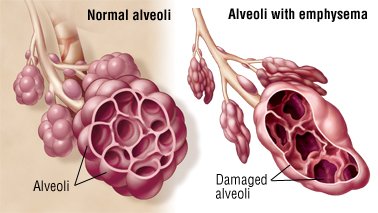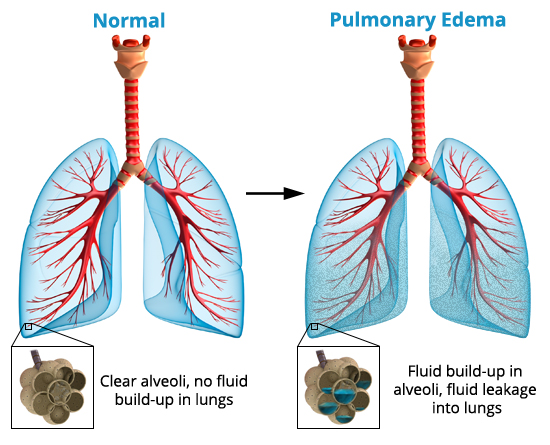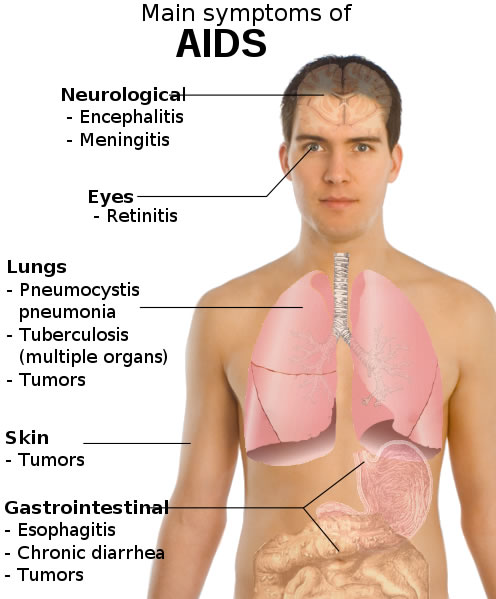coronary heart disease
Saturday, June 6, 2015
Respiratory System Disorders
EMPHYSEMA
Emphysema gradually damages the air sacs (alveoli) in your lungs, making you progressively more short of breath. Emphysema is one of several diseases known as chronic obstructive pulmonary disease (COPD).
Smoking may lead to emphysema.
The alveoli are clustered like bunches of grapes. In emphysema, the inner walls of the air sacs weaken and eventually rupture — creating one larger air space instead of many small ones. This reduces the surface area of the lungs and, in turn, the amount of oxygen that reaches your bloodstream.
When exhale, the damaged alveoli does not work properly and old air becomes trapped, leaving no room for fresh, oxygen-rich air to enter. Treatment may slow the progression of emphysema, but it can't reverse the damage.
Symptoms
- Tobacco smoke
- Air pollution
- Manufacturing fumes
restrictive lung disorders
•2 groups of diseases
1.Abnormalities
of chest wall which limits lung expansion
–Includes:
»Kyphosis
»Scoliosis
»Muscular dystrophy
2.Disease
affecting lung tissue that provides supporting framework
–Includes:
»Idiopathic pulmonary fibrosis
(autoimmune disease)
»Pulmonary edema
»Pulmonary embolism
»Acute respiratory distress syndrome
(ARDS)
1.PULMONARY EMBOLISM
1.PULMONARY EMBOLISM
Pulmonary embolism
Causes of pulmonary embolism
- prolonged immobilization, medications, fracture of legs
- smoking, genetic predisposition,
- an increased number of red blood cells (polycythemia), , pregnancy, surgery,
- pulmonary embolus clogs the artery that provides blood supply to part of the lung. The embolus not only prevents the exchange of oxygen and carbon dioxide, but it also decreases blood supply to the lung tissue itself, potentially causing lung tissue to die (infarct).
2.PULMONARY EDEMA
Pulmonary Edema
causes
–Left
sided heart failure
–Hypoproteinemia
–Inhalation
of toxic gases
-Lymphatic
blockage ( from tumor)
3. ACUTE RESPIRATORY DISTRESS SYNDROME
Acute Respiratory Distress Syndrome (ADRS)
Causes of ADRS
- Sepsis. The most common cause of ARDS is sepsis, a serious and widespread infection of the bloodstream.
- Inhalation of harmful substances. Breathing high concentrations of smoke or chemical fumes can result in ARDS, as can inhaling (aspirating) vomit.
- Severe pneumonia. Severe cases of pneumonia usually affect all five lobes of the lungs.
- Head, chest or other major injury. Accidents, such as falls or car crashes, can directly damage the lungs or the portion of the brain that controls breathing.
Friday, June 5, 2015
endocrine system disease
Pathogenesis of Endocrine system disease are:
- hyperfunction
- hypofunction of gland
- Receptor defect
- 2nd messenger defect
•Glucose level controlled by insulin and
glucagon
•Insulin promotes a decrease in blood
glucose
•Glucagon promotes an increase in blood
glucose
Pathophysiology of DM
Type 1 DM
This
is characterized by the destruction of the pancreatic
beta cells.
The
destruction of the beta cells results in decreased insulin production,
unchecked glucose
production by the liver and fasting hyperglycemia.
Glucose derived from food is not stored in the liver but remains in the blood
stream and
contributes to hyperglycemia(high blood sugar).
contributes to hyperglycemia(high blood sugar).
Type II DM
This the most common form of diabetes, often
associated with older age, obesity, family history or diabetes e.t.c.
In type 2 diabetes, the pancreas is usually producing enough insulin, but for unknown
reasons the body cannot use the insulin effectively, a condition called insulin resistance.
After several years, insulin production decreases. So thus glucose builds up in the blood and
the body cannot make efficient use of its main source of fuel.
This the most common form of diabetes, often
associated with older age, obesity, family history or diabetes e.t.c.
In type 2 diabetes, the pancreas is usually producing enough insulin, but for unknown
reasons the body cannot use the insulin effectively, a condition called insulin resistance.
After several years, insulin production decreases. So thus glucose builds up in the blood and
the body cannot make efficient use of its main source of fuel.
Diabetic ketoacidosis (DKA) (excess blood acids,ketones)
-is
a complex disordered metabolic state characterized by hyperglycemia and ketoacidosis.
DKA usually
occurs as a consequence of absolute or relative
insulin deficiency
(i.e Type 1 Diabetes Mellitus) and is
accompanied by lipolysis to increases serum free
fatty acids.
Hepatic metabolism of free fatty
acids as an alternative energy source (ketogenesis)
results in accumulation of acidic ketones
and ketoacids.
In addition, the decreased
glucose uptake by peripheral tissues due to insulin
deficiency will increases glucose
continue of immunology disorders(Rheumatoid Arthritis)
clinical manifestation of Aids
ØRheumatoid
arthritis (RA) is a chronic, systemic inflammatory disease that primarily
attacks peripheral joints and the surrounding muscles, tendons, ligaments, and
blood vessels.
ØRA
strikes women three times more often than it does men.
ØDirect
cause unknown.
Diagnostic test results
Symptoms:
Diagnostic test results
ØX-rays
show bone demineralization and soft-tissue swelling (early stages), cartilage
loss and narrowed joint spaces and, finally, cartilage and bone destruction and
erosion, subluxations, and
deformities (later stages).
ØRF titer is
positive in 75% to 80% of patients (titer of 1:160 or higher).
ØSynovial
fluid analysis shows increased volume and turbidity but decreased viscosity and
elevated white blood cell counts.
ØSerum
protein electrophoresis shows elevated serum globulin levels.
ØErythrocyte
sedimentation rate and C-reactive protein levels are elevated in 85% to 90% of
patients (may be useful to monitor response to therapy because elevation
frequently parallels disease activity).
ØComplete
blood count reveals moderate anemia, slight leukocytosis, and
slight thrombocytosis.
- fever,weight loss
- fatigue,lymphadenopathy
- malaise
Immunology disorders
AIDS?
ØHuman
immunodeficiency virus (HIV) infection may cause acquired immunodeficiency
syndrome (AIDS).
ØAlthough
characterized by gradual destruction of cell-mediated (T cell)
immunity,
AIDS also affects humoral immunity and
even autoimmunity through the central role of the CD4+
(helper) T lymphocyte in all immune reactions.
ØThe
resulting immunodeficiency makes the patient susceptible to opportunistic
infections, cancers, and other
abnormalities that define AIDS.
ØHIV-1
retrovirus transmitted by contact with infected blood or body fluids
HIGH-RISK
POPULATIONS
ØHomosexual
or bisexual men
ØI.V.
drug users
ØNeonates
of infected women
ØRecipients
of contaminated blood
or blood products
ØHeterosexual
partners of persons in high-risk groups
Subscribe to:
Posts (Atom)












